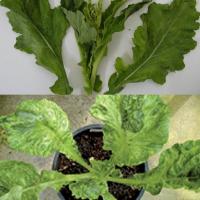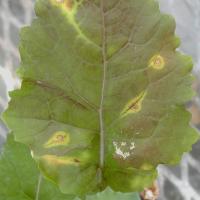Diagnosing turnip mosaic virus in canola
An aphid-borne viral disease in canola that has the potential to cause significant yield loss with early infection, but is uncommon.
What to look for
- Pale mottled and distorted, sometimes stunted plants that occur in patches, in thinner crop areas or the edge of the paddock, and gradually spread.
Paddock
- Varieties vary in susceptibility, however most current canola varieties are resistant.
- Leaves develop pale to yellow and green mottles and may have dead spots and line patterns.
- Severely affected plants are stunted, twisted and generally light green to yellow.
- Severely affected plants plants have fewer, twisted pods with less seeds.
Plant
What else could it be
| Condition | Similarities | Differences |
|---|---|---|
| Diagnosing Group I herbicide damage in canola | Distorted puckered leaves | Group I distortion is more pronounced with twisted stems, petioles and leaf veins, and plants are elongated rather than stunted. Damage is also more uniform across the paddock. |
Where did it come from?

Green bridge

Insect vector
- Turnip mosaic virus (TuMV) is not seed-borne. It survives in weeds or volunteer canola host plants outside the growing season and is spread from these infected plants into crops by aphids which act as vectors for virus transmission.
- Wild radish and volunteer canola are the most important weed hosts, but the virus does have a wide natural host range and many weed species can act as reservoirs for infection.
- It also infects mustard, and vegetable brassicas.
- TuMV is non-persistent, and is transmitted by many aphid species including the green peach and cabbage aphid. The virus is retained in the aphid mouthparts for short periods and lost when the infective aphid feeds on healthy plants.
- Autumn is the most critical infection period so earliest-sown crops are usually infected most.
- Infections can occur past the rosette stage of canola growth but these probably have little effect on yield.
Management strategies

Resistant varieties

Grass pasture control

Stubble management
- Many commercial varieties have infection resistance to this virus.
- Control broadleaf weeds (especially over summer) as they act as reservoirs for the viruses.
- Retain stubble at sowing to cover the ground, this reduces the ability of aphids to land on young canola plants thereby reducing virus spread.
- Manipulate sowing dates. Delay sowing to avoid exposure of young canola seedlings to peak aphid flights.
- Sow at high seeding rates. High plant density helps diminish the rate of virus spread and speeds up canopy closure resulting in lower aphid landing rates.
- Sow varieties with infection resistance.
See also
Where to go for expert help
Page last updated: Friday, 17 April 2015 - 9:12am




